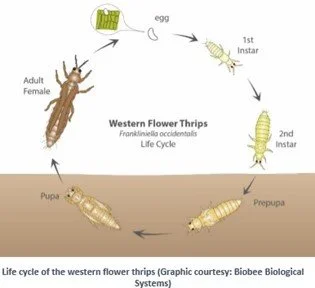THRIPS
Thrips are very small insects in the order Thysanoptera which are only slightly larger than spider mites, and hard to see with the naked eye. They are elongated and typically a tan or yellowish color although some species are darker brown or black. Thrips feed by scraping the outside of the leaves off and cause irregular silvery spots. They also damage young leaves as they are forming causing them to be distorted as they grow. They cause similar damage to flowers, infesting flower buds and damaging petals or even causing the flower to abort. In addition to damage from feeding they are also disease carriers and one of the most common vectors for many plant viruses.
Some strains of thrips have developed resistance to many pesticides while others are still more easily treatable. Thrips can be annoying to eradicate because they can lay eggs inside of plant parts and some stages of the lifecycle are spent in the soil. Typically it will require several treatments to eradicate them all.
Non pesticide options (not recommended):
Horticultural oil / dormant oil - This is a mechanical pesticide. It kills thrips by suffocating them and is only active on the exposed stages. It does not kill eggs and cannot be used to treat soil borne stages. It requires direct contact and has no residual action. Horticultural oil and other oil-based pesticides can damage leaves. They can cause burning or other damage to leaves if applied when temperatures are high (80-85F or higher) or if the leaves are sensitive. Always test it on a couple leaves first before spraying a whole plant
Soapy water & peroxide - Real soap like Dr. Bronner’s or safer insecticidal soap + 3-4 TBSP of 3% hydrogen peroxide per cup of water. Spray on and then use a soft, damp cloth to physically wipe the thrips off the leaves. Rinse with plain water. Direct contact only, no residual effect
Sticky traps – These will provide early warning of thrips but don’t do anything to control or suppress them
Insecticides
Spirotetramat — is the latest generation miticide and insecticide, offering broad systemic protection against spider mites, thrips, scale, mealybugs and more. Given its recent entrance to the market it works exceptionally well against mites that have developed resistance to other more common miticides. It is active on eggs, larvae, and nymphs and adults. Unlike any other miticide it works systemically, and is absorbed from the soil up to the leaves, as well as from leaf to leaf, and will provide resistance for up yo 30-45 days.
Spinosad - Spinosad is an insecticide based on chemical compounds found in the bacterial species Saccharopolyspora spinosa. It is highly active on most species of thrips and kills on contact as well as ingestion so there is some residual effect. It should be applied to the tops and bottoms of leaves taking care to get it down inside young leaves. The same concentration used for spraying leaves should be applied to the roots as a soil drench.
Spinosad is widely available including from home depot and lowes sold as either Monterey garden insect spray concentrate in a quart for $20 or as Captain Jack’s Dead Bug Brew concentrate in a 16 oz container for about $15
Spinosad can also be tank mixed with abamectin (Avid), if your thrips are resistant to just spinosad this should obliterate them. It is most common 2-part tank mixture used by nurseries for treating thrips: Tank mixing abamectin and spinosad
Abamectin – Abamectin is sold as Avid and is a miticide designed for spider mites. It also controls thrips and can be tank mixed with spinosad for dealing with resistant strains. See “Avid” in spider mite section for more info (can be purchased for $90 here)
Azadirachtin – Azadirachtin is a limonoid chemical derived from neem seeds that acts as an antifeedant and insect growth regulator (IGR). It is significantly more effective as a pesticide than cold pressed neem oil. Since it is oil based it should be applied early morning or late evening to avoid burning leaves plus it is safe for pollinators once dried. It has a short-term residual effect.
Azadirachtin is sold in the US under the brand name Azamax from General Hydroponics. You can find it on amazon in a 4oz bottle for about $25
Imidacloprid – Imidacloprid is a systemic neonicotinoid that kills everything except for spider mites and hard scale. It is available in granular form that is applied to the soil and provides protection for up to 90 days. Given its extreme toxicity to pollinators, many states in the US have banned it, but where it is allowed to be sold it can be purchased for as little as $10. See “Imidacloprid” in the mealybug section for more information



